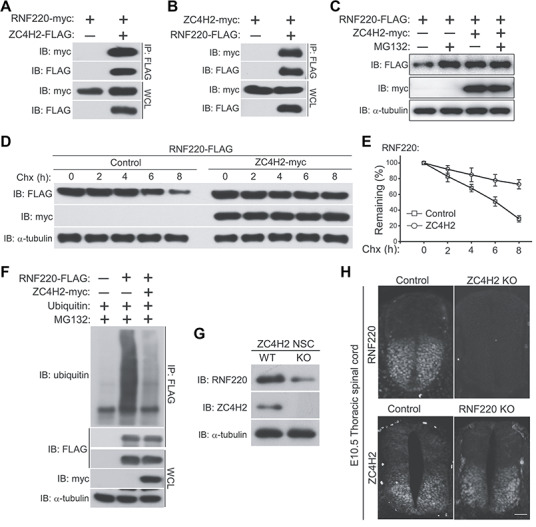Figure 5.

ZC4H2 interacts with and stabilizes RNF220 in vitro and in vivo. (A) RNF220 is coimmunoprecipitated with ZC4H2. (B) ZC4H2 is coimmunoprecipitated with RNF220. HEK293 cells were transiently transfected with different combinations of RNF220 and ZC4H2 expression vectors. Cell lysates were incubated with anti-FLAG beads, washed, and subsequently analyzed by western blotting. (C) RNF220 protein is stabilized by ZC4H2 overexpression. FLAG-tagged RNF220 and myc-tagged ZC4H2 plasmids were transfected into HEK293 cells as indicated. After 40 h, cells were treated with 15 μM MG132 or not before harvest and then cell lysates were analyzed by western blotting. (D and E) Effect of ZC4H2 on the stablity of RNF220. HEK293 cells were transiently transfected with the indicated plasmids. At 48 h post-transfection, cycloheximide (Chx) was added to all samples, and the cells were harvested at the time points indicated. Levels of RNF220 were determined by western blotting with anti-FLAG antibody. In all cases, α-tubulin was used as a loading control. The relative levels of RNF220 were quantified densitometrically and normalized against α-tubulin and the statistics are shown in E. (F) In vitro ubiquitination assay showing that polyubiquitination level of RNF220 is reduced by ZC4H2 coexpression in HEK293 cells. (G) Western blotting assay showing the protein level of RNF220 in wild-type (WT) or ZC4H2 knockout (KO) neural stem cells. (H) Immunofluoscence staining showing the RNF220 or ZC4H2 protein expression in wild-type (Control) or ZC4H2/RNF220 knockout (KO) mouse spinal cords at E10.5. Scale bar, 75 μm. IB, immunoblot; IP, immunoprecipitation, WCL, whole-cell lysate.
